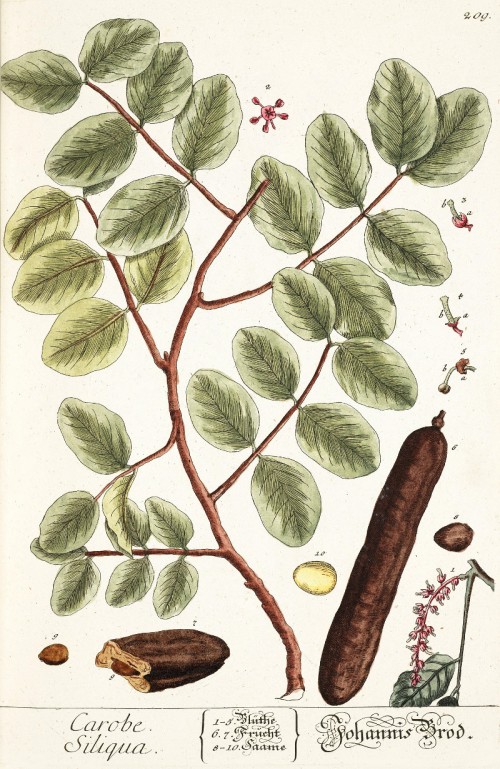Benutzer-Werkzeuge
Dies ist eine alte Version des Dokuments!
Ceratonia siliqua L. - Fabaceae - carob (bean), locust bean, St John's bread, Johannisbrotbaum
Evergreen shrub or tree, native to Africa, Western Asia and Southern Europe; leaves alternate, pinnate, leathery; flowers in racemes, minute, bearing 5 fused sepals and 5 stamens, without petals; fruit a leathery pod with numerous shiny seeds in.
„The [fruit] pulp contains about 48 - 56% of sugars and 18% of cellulose and hemicellulose… Carob pulp is sold as flour or chunks. It can be also consumed directly from the dried (and sometimes roasted) pod. Carob is mildly sweet and is used in powdered, chip, or syrup form as an ingredient in cakes and cookies.“
http://en.wikipedia.org/wiki/Ceratonia_siliqua
The grinded endosperm of the seeds is used as stabilizer and thickener in food products and pharmaceuticals. „Locust bean gum occurs as a white to yellow-white powder. It consists chiefly of high-molecular-weight hydrocolloidal polysaccharides, composed of galactose and mannose units combined through glycosidic linkages, which may be described chemically as galactomannan.“
http://en.wikipedia.org/wiki/Locust_bean_gum
„The endosperm is the galactomannan carob bean gum (CBG). It is a polysaccharide molecule composed of mannose and galactose sugar units (ratio 4:1) rather similar to guar gum (2:1) and tara gum (ratio 3:1). The main property of this natural polysaccharide is the high viscosity of the solution in water, over a wide range of temperature and pH.“
[Battle, I., and J. Tous. Carob tree: Ceratonia siliqua L.-Promoting the conservation and use of underutilized and neglected crops. 17. Bioversity International, 1997]
„The etymology and mass of the carat support its direct descent from the carob bean via the ancient Roman siliqua. However, our analysis shows that carob is not unusually invariant in seed mass when compared to 63 other species. The variability of carob seeds within individual pods and trees declines with increasing seed mass, most likely because the variance remains constant, giving some pods with large seeds very low CVs. This new observation provides one possible explanation for the carob myth; however, it seems more likely that the myth arose from consideration of collections of seeds used for weighing, which had already been subjected to strong human selection. Our study shows that people are remarkably good at selecting seeds by eye, and can discriminate differences in weight of around 5%. In this instance, human selection seems, unusually, to have been stabilizing rather than directional leading to a distribution of carat weights around the mean weight of carob seeds rather than at the higher end of the distribution. This might reflect the conflicting interests of buyers and sellers, one of whom would always prefer bigger seeds and one of whom would always prefer smaller. Carob was perhaps chosen for use as a weight simply because of its ready availability—it spread widely around the Mediterranean in Classical times from its centre of origin in the Horn of Africa and southern Arabia -and perhaps owing to its useful size. It is likely that one-carat diamonds were traded in ancient times even in Europe: the marks of diamond drills have been found on Roman antiquities and even on beads in Yemen dated to the fourth century BC, raising the possibility of a truly ancient association between diamond and carob.“
[Seed size variability: from carob to carats., Turnbull, L. A., Santamaria, L., Martorell, T., Rallo, J., Hector, A., Biology Letters, Vol.2(3), 2006, 397-400]
http://www.ncbi.nlm.nih.gov/pmc/articles/PMC1686184/?tool=pmcentrez

Blackwell,E., Herbarium Blackwellianum, vol.3, t.209 (1757)
http://plantgenera.org/species.php?id_species=224812
